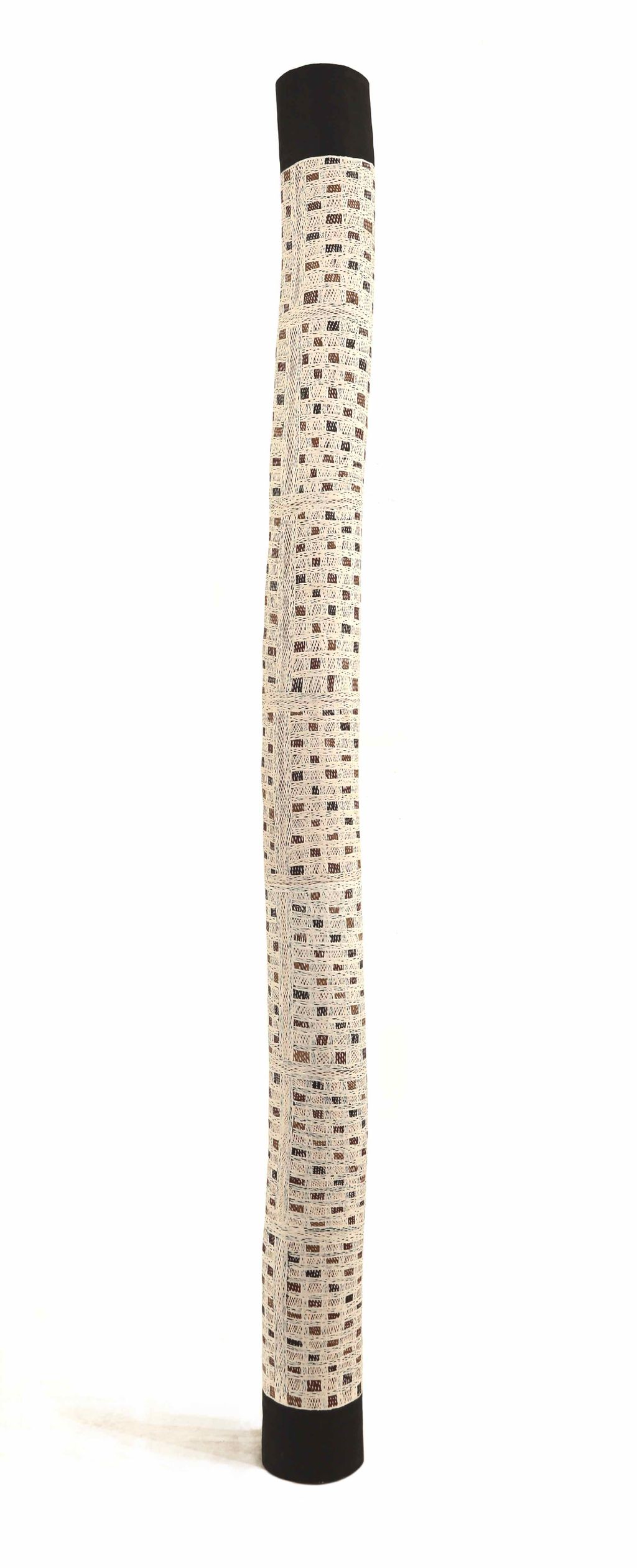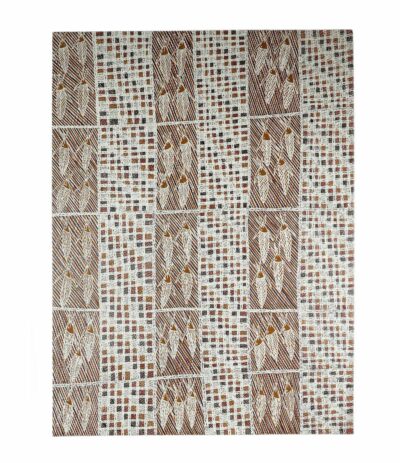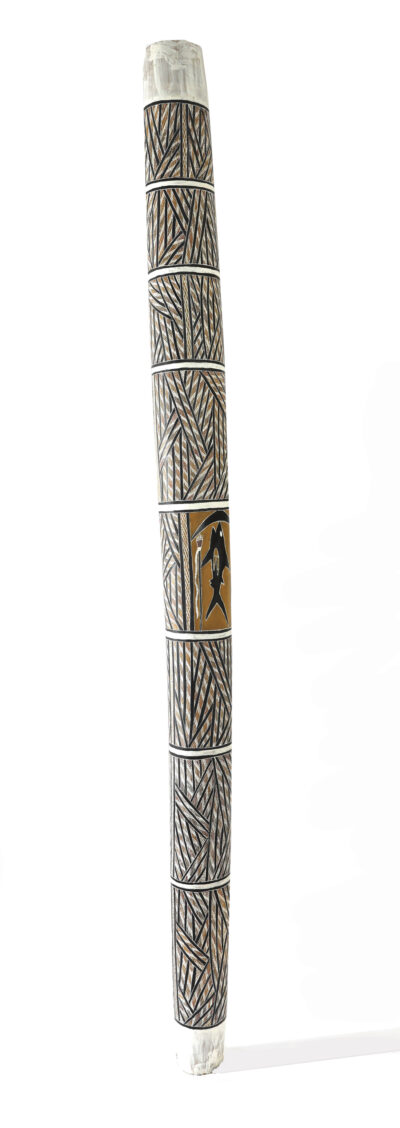Description
yimula munungurr
Earth pigments on Stringybark hollow pole
109cm x 12cm
Year: 2023
ID: 718-23
Djapu Design
The cross hatching grid pattern is the sacred design for the freshwaters of the Djapu clan at their homeland Waṉḏawuy now an outstation about 150 kilometres south of Yirrkala and inland from Blue Mud Bay.
This Djapu clan outstation (and spiritual residence for Ancestral Beings Mäna, the Shark and Bol’ŋu the Thunderman) is surrounded by permanent freshwater. Rains inspired by the actions of Bol’ŋu feed the rivers and fill the billabongs. Catfish and mussels, freshwater crayfish and others feed the Yolŋu and wild life. The waters are home for the shark Mäna.
The grid refers to the landscape of Waṉḏawuy – a network of billabongs surrounded by ridges and high banks. Its structure also having reference at one level to woven fish traps. Ancestral Hunters set a trap here to snare the Shark but to no avail. These Yolŋu people are called Bärŋbarŋ and Monu’a who came to cut the trees named Gu’uwu, Gathurrmakarr, Nyenyi, Rulwirrika and Gananyarra – all Dhuwa trees. They used straight young trees. And cut them with their axes called Gayma’arri, Bitjutju.
Areas of the river are staked by the Yolŋu and branches interwoven through them. Then the water is polluted by a particular pulped bark that anaesthetises the Gaṉŋal that hobble to the surface. With nets constructed similarly to the the beak of Galumay, the Pelican, the Yolŋu wade through the waters scooping up the fish. It has been fished since Ancestral times. Gaṉŋal the catfish, totem for the Djapu is ceremonially sung as is Galumay the pelican. Both these species frequent the waters of Waṉḏawuy.
Mäna the Ancestral Shark in its epic travels comes through this way. These ancestors try to trap Mäna in the freshwater by means of these traps in the waterways. They fail. The powers and physical strength of the Shark overcome the efforts of mere mortals. Mäna’s ire and thrashing tail smash the trap and muddy the water. They witness however the strength of Mäna and sing his actions, the thrashing of his tail for one, the muddying or contamination of the water.
The grid lines having reference to the trap, the cross hatched squares referring to differing states of the freshwater – the source of Djapu soul. At ceremony appropriate participants for mortuary rites enter the shelter (woven together like the unsuccessful trap) where the deceased has been lying in state. Sacred spears tipped with stingray barbs, manifestations of Mäna’s teeth, stand up alongside the shelter. The sacred song cycles of Mäna in the water at Waṉḏawuy are intoned with music from the Yiḏaki (didjeridu) and Bilma (clapsticks). At the prescribed time at the conclusion of ceremony the dancers crash through the deceased’s shelter imitating the actions of Mäna at the trap. This action has reference to the release of the deceased’s soul, back to the sacred waters of Waṉḏawuy to be reunited with its ancestors awaiting rebirth.
Waṉḏawuy literally means place of the Sharks head where in the larger context of the song cycles of Mäna’s journey his head came to rest after being butchered and distributed through the land.
The Larrakitj had its traditional use for the Yolŋu of North east Arnhem Land as an ossuary or bone container erected as a memorial to a dead kinsman up to a decade after death. After death the body of the deceased was often ceremonially placed on a raised platform and left to the elements for an appropriate time. The area would then be abandoned until the next stage of the ritual.
This took place once it was determined that the essential eternal spirit of the deceased had completed its cyclical journey to the spring from which it had originated and would in time return again. This might be several years. Whilst the body was ‘lying in state’ others got wind of the death, perhaps by subliminal message and made preparations to journey to the site of mortuary. Usually enough time had elapsed for the bones of the deceased to be naturally cleansed on the platform. The essence of the soul within the bone was made ready for final rites when other outside participants necessary for its safe journey arrived. Ritual saw the bones of the deceased placed within the termite hollowed memorial pole for final resting. Mortuary ritual would end with the placement of the Larrakitj containing the bones standing in the bush. Over time the Larrakitj and its contents would return to mother earth.
The Larrakitj has often been referred to as the mother’s womb. Once sedentary mission communities were established in Arnhem Land it became impractical to abandon permanent communities and outlawed to expose corpses on platforms. However the cosmology of the Yolŋu and the essence of ritual mortuary ceremony remains just as important. Larrakitj continue to be produced as the equivalent of headstones or to contain the personal effects of a deceased (which might be dangerous unless removed from the living because of the emanations imbued by contact with the deceased).
A further role for this cultural form is as a fine art object and an instructional tool for younger generations. Artworks of this nature have multiple layers of metaphor and meaning which give lessons about the connections between an individual and specific pieces of country (both land and sea), as well as the connections between various clans but also explaining the forces that act upon and within the environment and the mechanics of a spirit’s path through existence. The knowledge referred to by this imagery deepens in complexity and secrecy as a person progresses through a life long learning process.






Reviews
There are no reviews yet.